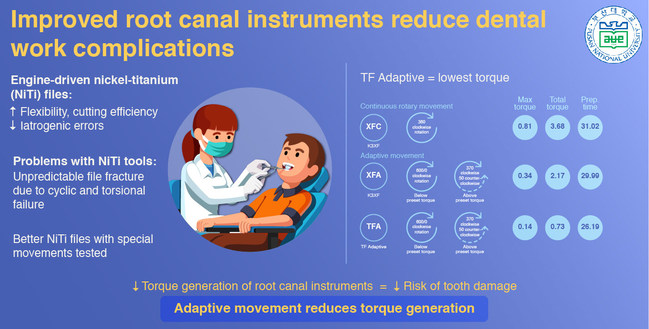As shown in this infographic, adaptive movement of the NiTi files was better than continuous rotary movement; this was reflected in lower total torque (Ncm) and shorter preparation times (seconds)
Doctors suggest that the "adaptive" motion of nickel-titanium rotary files used for root canal procedures decreases the instrument's torque generation, thereby reducing the risk of tooth damage and file fracture
Reducing dental work complications is in best interest of dentists as well as patients. To improve clinical performance of root canal instruments, a research team, led by Dr. Sang Won Kwak from Pusan National University, South Korea, tested instrumentation with specially designed rotary movements. Their study, published in Journal of Endodontics, suggests that adaptive movement of nickel-titanium (NiTi) files improves the success rate of root canal treatment by lowering the torque generation of the instruments. A lower torque will help reduce the risk of tooth damage and file fracture.
Over the years, root canal dental work has been improved with the use of engine-driven NiTi files. Compared with stainless-steel manual files, NiTi instruments offer better flexibility and cutting efficiency, in addition to reduced iatrogenic errors. However, the NiTi files may have cyclic fatigue and torsional failure problems during the root canal procedure. To reduce the risk of file fracture, Dr. Kwak tested heat-treated NiTi alloy files with specially designed rotary movements.
The scientists tested three types of instruments/movements for the root canal procedure: The K3XF rotary system with 1) continuous rotary movement (XFC) or 2) adaptive movement (XFA), and 3) the Twisted File with adaptive movement (TFA), all from the endodontic product manufacturer Kerr Endodontics. "Adaptive motion" combines continuous and reciprocating (clockwise and counterclockwise directions) movements rotating 600˚, stopping when the file is exposed to minimal or no load. According to Dr Kwak, "Adaptive movement helps to reduce torque generation during instrumentation with NiTi rotary files." Torque generation occurs while removing root dentin by engine-driven NiTi files. The generated torque implies the energy required to cut root dentin, but also represents the reaction stress to NiTi files as well as the root dentin.
To ensure consistent test conditions, endo-training resin blocks—acrylic blocks used in dentistry to simulate a root canal—were used for all instruments. Each block contained an S-shaped artificial canal, with a working length of 16 mm. The instrumental procedure was performed by a single, experienced endodontist to reduce operator errors, for a total of 45 tests (15 per instrument).
The researchers found that TFA generated the lowest torque. Dr. Kwak and colleagues thus concluded that the adaptive movement for NiTi files may reduce torque generation without increasing preparation time. Dr. Kwak also suggests that the "torque generation is more likely to be affected by the cross-sectional area rather than the movement of the file system." A smaller cross-sectional area may account for the lower torque generation in the TFA file system.
These findings are promising for instrumentation in root canal procedures in the future. The next steps would be to assess the feasibility of these improved instruments in real-life situations in patients in the OR, as opposed to the well-controlled laboratory conditions of this study.





